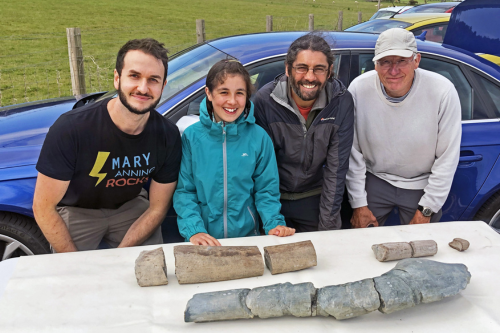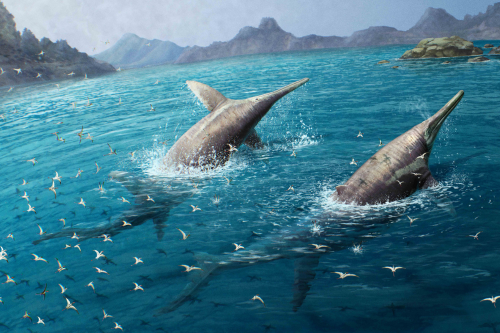
A fossil found by an 11-year-old girl on a beach in England has helped scientists identify a new species of prehistoric ocean reptile.
In May 2020, Ruby Reynolds and her father, Justin Reynolds, were strolling along a beach in England, near the village of Blue Anchor. They were looking for fossils. Ruby spotted a large piece of fossilized bone sitting on top of a boulder, almost as if someone had left it there. She and her father searched back and forth along the beach and found a second bone fossil, similar to the first one.
They thought the fossils might be part of a large animal jawbone, so they took them home to see if they could identify what type of creature they came from.
They found a scientist’s report about similar jawbone pieces that had been discovered at a nearby beach four years earlier.
Those fossils belonged to an ichthyosaur [pronounced like ick-thee-a-sor]. Ichthyosaurs are reptiles that lived in the ocean at the same time dinosaurs were living on the land.
Ruby and Justin contacted the people who had written the report. Dr. Dean Lomax of the University of Bristol is an expert on ichthyosaurs. And Paul de la Salle is an experienced fossil hunter. He is the one who had found the earlier jawbone fragments.
The four of them, along with other members of Ruby’s family, returned to the beach near Blue Anchor to look for more pieces of the jawbone. Digging in the mud with shovels, they found several more fossils that fit together to form part of a jawbone. When it was pieced together, it was more than two metres long.
The bones are about 202 million years old. They belonged to a gigantic ichthyosaur that lived in the ocean during the late Triassic Period.
Its body was probably about 25 metres long, or the size of a blue whale–or two buses!
It appears to be the largest marine reptile ever discovered. It is also believed to be a new species of ichthyosaur.
When Dr. Dean Lomax examined the pieces of fossilized bone found by Paul de la Salle in 2016, he saw that they had some unusual features that were different from any known species of ichthyosaur. The fossils were also from a time roughly 13 million years ago. That is later than any other gigantic ichthyosaur that had been identified.

An artist’s drawing of “A giant pair of swimming Ichthyotitan severnensis” by Gabriel Ugueto. Posted on the University of Bristol website (media release).
At the time, Dr. Lomax thought the fossils might be from a species of ichthyosaur that had never been seen before, but he didn’t have enough information to prove it.
When he examined the fossils Ruby and her father found, he discovered that they came from the same time period as the pieces Paul de la Salle had found. They also had the same unique features as those fossils.
It was the additional evidence he needed. The new pieces found by Ruby and her father supported the theory that both sets of fossils belong to a species of ichthyosaur that has never been identified before.
The team named the new species Ichthyotitan severnensis, which means “giant fish lizard of the Severn.” (In this case, Severn refers to the Severn Estuary near where Ruby and her father found the fossils.)
Ruby Reynolds, who is now 15, says it is very cool to be part of such an important discovery.
THINK AND DISCUSS
The length of the new species is given in metres and two examples of things that length are also given. What are some other things that are about 25 metres long? Did the examples help you to picture how big the species would be?
What is your favourite prehistoric creature? Why?
Ruby Reynolds found the fossilized bone fragment. How do you think she knew it wasn’t just a stone or some other kind of common substance?
If you found what you thought might be a fossil, what is the first thing you would do?
The article mentions the “late Triassic Period.” What (or when) is that?
LINKS TO MORE INFORMATION
Ichthyosaurs 101, National Geographic video: https://www.youtube.com/watch?v=OfZnBV_LFZc
Ichthyosaur Facts for Kids: https://kids.kiddle.co/Ichthyosaur
Digging for Dinosaurs, CBC Kids video: https://www.youtube.com/watch?v=20su_vqPZx4
University of Bristol media release: https://www.bristol.ac.uk/news/2024/april/giant-ichthyosaur-discovery.html
Take a deeper dive into the science with this research article about the discoveries, by scientists Dean R. Lomax, Paul de la Salle, Marcello Perillo, Ruby Reynolds, Justin Reynolds and James F. Waldron: https://journals.plos.org/plosone/article?id=10.1371/journal.pone.0300289
Article on Live Science website (includes other artist’s renderings) https://www.livescience.com/animals/extinct-species/giant-82-foot-lizard-fish-discovered-on-uk-beach-could-be-largest-marine-reptile-ever-found

Click on the link below to purchase via Amazon.ca a book we highly recommend: Mary Anning’s Curiosity. It was written by brilliant author Monica Kulling and traces the journey of “the world’s greatest fossilist” back to one of her very first finds, as a young girl. If you purchase the book using the link below, TKN will receive a small amount of money from Amazon (yay!). But you can also buy it from your independent bookstore or get it from the library.








